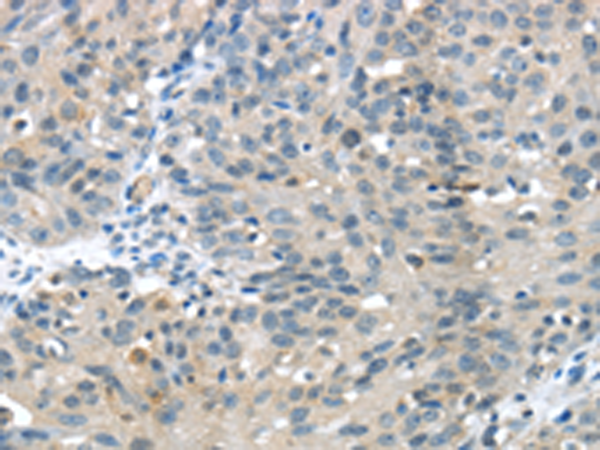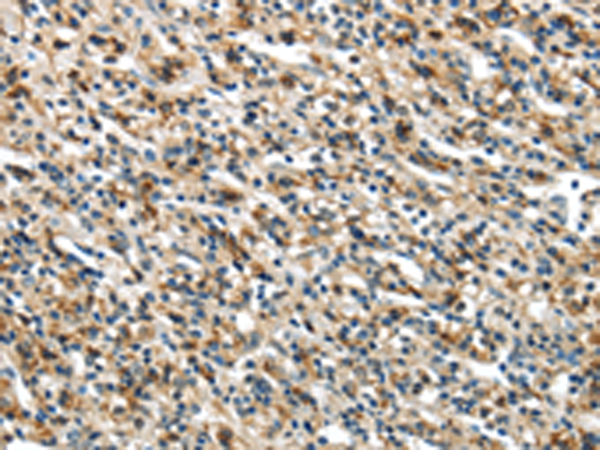


| WB | 咨询技术 | Human,Mouse,Rat |
| IF | 咨询技术 | Human,Mouse,Rat |
| IHC | 1/25-1/100 | Human,Mouse,Rat |
| ICC | 技术咨询 | Human,Mouse,Rat |
| FCM | 咨询技术 | Human,Mouse,Rat |
| Elisa | 1/2000-1/5000 | Human,Mouse,Rat |
| WB Predicted band size | 63 kDa |
| Host/Isotype | Rabbit IgG |
| Antibody Type | Primary antibody |
| Storage | Store at 4°C short term. Aliquot and store at -20°C long term. Avoid freeze/thaw cycles. |
| Species Reactivity | Human, Mouse |
| Immunogen | Fusion protein of human GLP2R |
| Formulation | Purified antibody in PBS with 0.05% sodium azide and 50% glycerol. |
+ +
以下是3篇关于 **GLP2R抗体** 的参考文献及其摘要概述:
---
1. **文献名称**: *"Monoclonal antibodies against the glucagon-like peptide-2 receptor (GLP2R) for tissue-specific targeting"*
**作者**: Yusta B, et al.
**摘要**: 该研究报道了针对GLP2R的单克隆抗体的开发,验证了其在多种小鼠组织(如肠道和脑部)中的特异性结合能力,并展示了其在免疫组化和流式细胞术中的应用潜力。
---
2. **文献名称**: *"GLP2R expression in gastrointestinal diseases and its potential therapeutic implications"*
**作者**: Munroe DG, et al.
**摘要**: 本研究利用特异性GLP2R抗体分析胃肠道疾病模型中受体的分布与表达变化,发现GLP2R在肠上皮修复中的关键作用,提示其作为治疗靶点的可能性。
---
3. **文献名称**: *"The role of GLP2R in nutrient absorption and intestinal adaptation: Insights from antibody-based studies"*
**作者**: Brubaker PL, et al.
**摘要**: 通过抗体验证GLP2R在肠道细胞中的功能,研究揭示了受体激活后促进营养吸收和肠道适应的机制,为代谢性疾病治疗提供了实验依据。
---
如需更详细文献信息,建议通过 **PubMed** 或 **Google Scholar** 搜索上述作者及关键词。
The glucagon-like peptide-2 receptor (GLP2R) is a G protein-coupled receptor (GPCR) primarily expressed in the gastrointestinal tract, central nervous system, and select endocrine tissues. It binds glucagon-like peptide-2 (GLP-2), a gut-derived hormone involved in intestinal growth, nutrient absorption, and mucosal repair. GLP2R activation triggers signaling pathways like cAMP/PKA, promoting cell proliferation, inhibiting apoptosis, and enhancing barrier function in the gut.
GLP2R antibodies are critical tools for studying receptor localization, expression patterns, and functional roles in physiological or pathological contexts. They enable applications such as immunohistochemistry, Western blotting, and flow cytometry to map GLP2R distribution in tissues or assess its regulation in diseases like short bowel syndrome, inflammatory bowel disease (IBD), or obesity. Commercially available antibodies target specific epitopes (e.g., extracellular or intracellular domains) and vary by species reactivity (human, mouse, rat).
Research using GLP2R antibodies has clarified its therapeutic relevance. For example, GLP-2 analogs (e.g., teduglutide) exploit GLP2R signaling to treat intestinal insufficiency. Dysregulated GLP2R expression is also linked to metabolic disorders and cancer, highlighting its dual roles in homeostasis and disease. However, challenges remain in validating antibody specificity due to GPCR structural homology and low receptor abundance. Recent advances in monoclonal antibody development and epitope tagging have improved detection reliability, supporting deeper mechanistic insights into GLP2R biology.
×